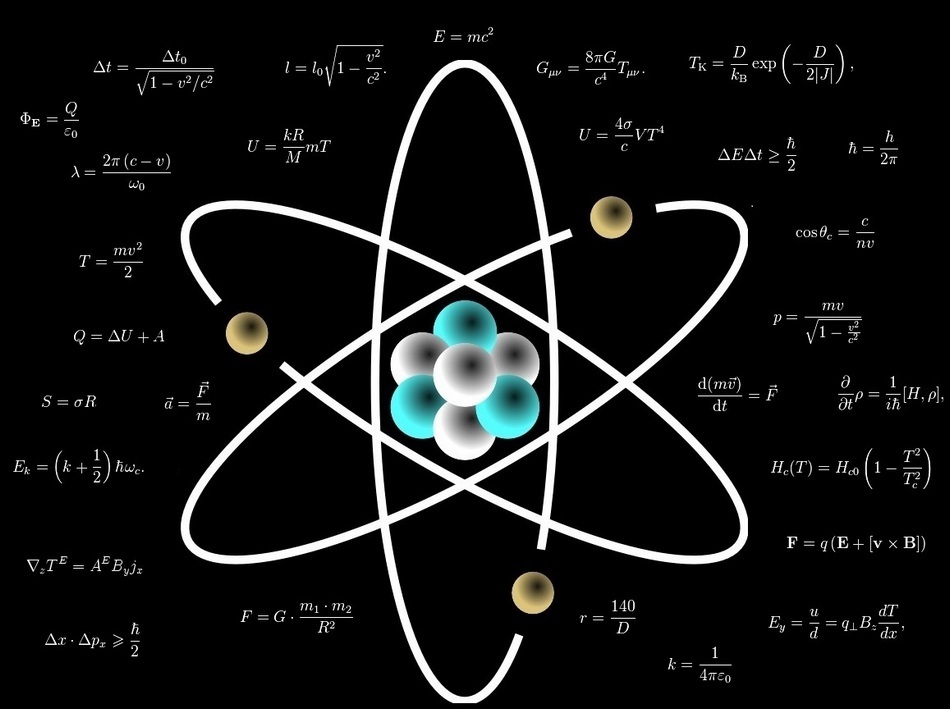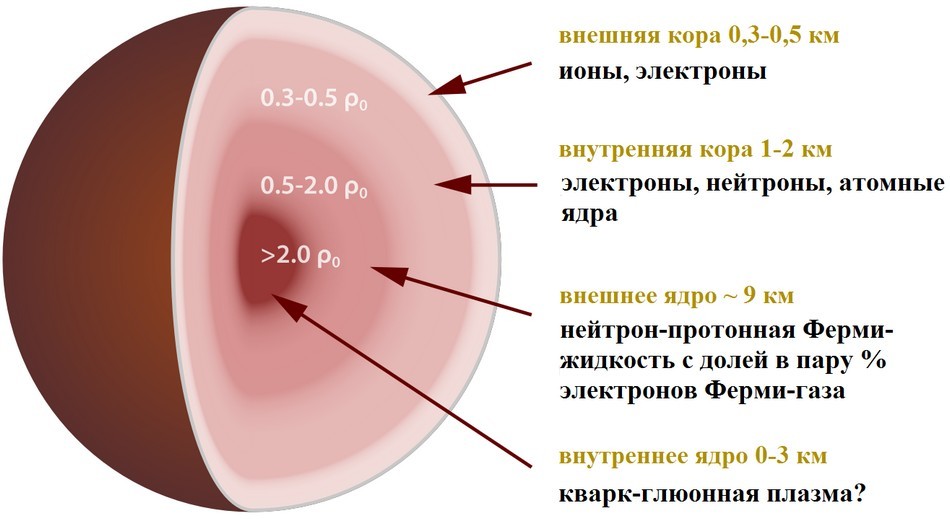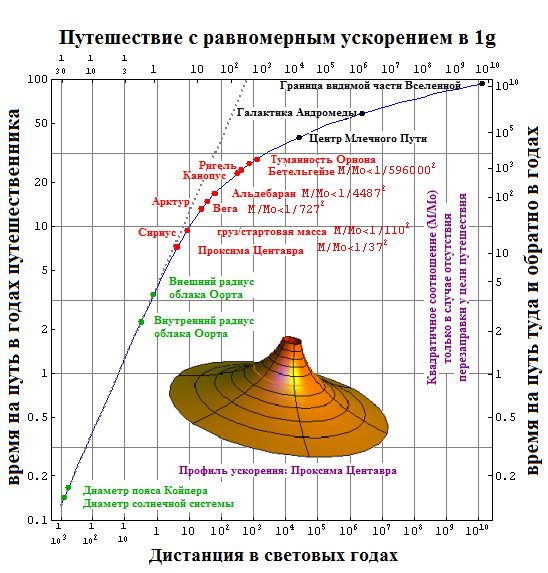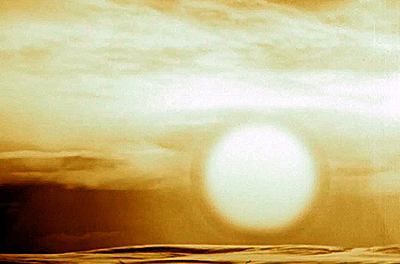Physical laws in numbers - large quantities
Many are familiar with the fact that the influence of certain laws of physics on our world, which is at the crossroads of the microworld of elementary particles, and the macroworld of stars and galaxies can be very large, but not everyone knows how much. Here I have collected a few examples of how much effect they can have.

Classical mechanics
The acceleration of free fall increases in direct proportion to body mass, and inversely proportional to the square of the radius:

And since the mass of celestial bodies generally grows from a third degree radius (body volume), but in reality even a little more (the density of heavy bodies is higher), such heavy bodies as giant planets and stars attract very distant bodies. .
')
Already on the conditional surface of Jupiter (gas giants and stars have the same very conditional boundary as the Earth’s atmosphere), you would have weighed 2.5 times more, and on the Sun it is almost 28 times more (a person can withstand such acceleration). only for a couple of seconds ). Due to its small size, for a white dwarf, the acceleration of gravity will already be 250,000 times higher than that of the earth. And for the most massive neutron stars - already 200 billion times more. This is enough to crush not only the human body, but even any atoms:

The composition of the neutron star
The density of such stars is huge - from 3.7 × 10 17 to 5.9 × 10 17 kg / m 3 . Under conditions of increased attraction, one cubic nanometer of their substance (in which under normal conditions less than a thousand atoms are placed) on the surface of a neutron star should weigh about 100 kilograms. But a further increase in the mass of bodies leads to a completely opposite effect — with the formation of a black hole, the acceleration of free fall (on the conventional surface of the body, the event horizon) becomes constant:

And the further increase in mass leads to a decrease in density - the black hole density formula shows that it is inversely proportional to the square of its mass, and does not depend on anything else:

So for a black hole with a mass of 4.31 million solar masses, like Sagittarius A * (an object in the center of our galaxy - the Milky Way), the diameter will be 17 times higher than the solar, and the density will be 10 6 kg / m 3 . And for the black hole in the center of NGC 4889, which has 21 billion solar masses (Gargantua mass from the film “Interstellar” for example - “only” 100 million) - the density will be 41 g / m 3 , which is two times lower than the density of hydrogen at atmospheric pressure .
Effects of the theory of relativity
At low speeds, the effects of the theory of relativity are very weak. However, with its growth, everything changes dramatically - for example, the graph, which shows the flight time to different points of the Universe with uniform acceleration and deceleration half way with acceleration of 1g:

The dotted line shows flight time without taking into account the relativistic time dilation. The annihilation reaction is taken as the energy source in the calculations of the payload / starting mass ratio.
The particle “oh my god” - which had the largest of the registered energies among the particles that came to us from space, had an energy of 3 * 10 20 eV - which is approximately 48 joules - this is 40 million times higher than the energy achieved in the LHC . If this particle was a proton (this is the basic version), then during the year of the flight it would be only 47 nm behind the beam of light. When approaching the speed of light, the time dilation goes very quickly:

And the time for it would be slowed down 300 billion times compared with a fixed observer - this means that having flown the entire Universe (the size of which is now estimated at 91 billion light years), only about 100 days would pass for him.
Quantum effects
As is known, the radiation of black holes ( Hawking radiation ) is associated only with their mass:

For a black hole with a mass equal to the Sun (the lower limit for black holes formed from stars - even slightly higher) will evaporate over a long time - 2 * 10 67 years (which is 57 orders of magnitude longer than the Universe) and detect black holes in this radiation is possible only at the very last stage of their evaporation (before that - evaporation is very slow, and the radiation is almost imperceptible) - therefore, at the moment it is impossible to detect them.
Moreover, the temperature of the “surface” of a black hole with a mass equal to that of the Sun is only 6 * 10 -8 K (this is despite the fact that the background radiation has a temperature of ≈ 2.7 K), which means that at the moment they do not even evaporate and vice versa - grow! So now astronomers hope to find smaller black holes that could theoretically form at the early stage of the Universe (when matter was extremely dense, and due to small irregularities in its expansion could collapse into a black hole).
For black holes in the centers of galaxies, the time of their existence (it depends on the 3rd power of the mass):
it becomes even more enormous - the black hole in the center of the Milky Way should exist 10 77 more than the time that the Universe already exists (13.799 ± 0.021 billion years), and the largest known at the moment should exist ≈2 * 10 98 years ( 10 88 times longer than the Universe).
Due to the dependence solely on its mass, the power of the “explosion” of the black hole at the last moment is the same for all of them. A second before the final evaporation (it is assumed that a stable black hole with Planck dimensions should eventually remain) its mass will be 2.28 * 10 5 kg, and for this last second 6.84 * 10 21 J of energy will be released (about 5 * 10 12 tons of TNT equivalent).
Nuclear physics
The most famous effect is the amount of energy released in the processes of nuclear reactions. So the first atomic bomb exploded on July 16, 1945 during the tests of Trinity had a mass of 108 tons, the amount of energy released was equivalent to an explosion of 21 thousand tons of TNT. And the most powerful thermonuclear bomb in the history of mankind, exploded already on October 30, 1961 - with a weight of 26.5 tons, had the TNT equivalent of 58 million tons (2.4 * 10 17. However, the mass defect (the mass directly converted into energy by the formula E = mc 2 ) made up only 2.65 kg, or only 0.1% of the total mass.

It would seem that the value is still huge, but on the scale of the planets, this is already a negligible value: in order to melt the Martian ice caps at the poles, it would take about 55 thousand of these bombs, or 73 tons of antimatter. However, so far the resulting amount of antimatter is measured in hundreds of atoms (a value of the order of 10 -21 kg), and its retention time is in minutes. What is good in general is that studies on its use in weapons by hundreds of atoms are already underway . At the same time, antimatter has no restrictions on minimum power and charge mass (like nuclear and thermonuclear weapons), but only one gram of antimatter is equivalent to 43 thousands of tons of trotyl - it is scary to imagine what such a weapon would be capable of.
The mass of an average person is 62 kg , which is approximately equal to 5.9 * 10 27 atoms, or almost 1.4 * 10 29 currently indivisible particles (quarks and electrons). And the total charge of electrons and protons in the human body is 3 * 10 9 Coulomb, or approximately 900 thousand A * h (amer-hours). The charge of the car battery for comparison is about 50 Ah. We do not notice such a monstrous charge and its effects due to the fact that the negative charge of electrons is balanced by the positive charges of protons in the atoms.

Classical mechanics
The acceleration of free fall increases in direct proportion to body mass, and inversely proportional to the square of the radius:

And since the mass of celestial bodies generally grows from a third degree radius (body volume), but in reality even a little more (the density of heavy bodies is higher), such heavy bodies as giant planets and stars attract very distant bodies. .
')
Already on the conditional surface of Jupiter (gas giants and stars have the same very conditional boundary as the Earth’s atmosphere), you would have weighed 2.5 times more, and on the Sun it is almost 28 times more (a person can withstand such acceleration). only for a couple of seconds ). Due to its small size, for a white dwarf, the acceleration of gravity will already be 250,000 times higher than that of the earth. And for the most massive neutron stars - already 200 billion times more. This is enough to crush not only the human body, but even any atoms:

The composition of the neutron star
The density of such stars is huge - from 3.7 × 10 17 to 5.9 × 10 17 kg / m 3 . Under conditions of increased attraction, one cubic nanometer of their substance (in which under normal conditions less than a thousand atoms are placed) on the surface of a neutron star should weigh about 100 kilograms. But a further increase in the mass of bodies leads to a completely opposite effect — with the formation of a black hole, the acceleration of free fall (on the conventional surface of the body, the event horizon) becomes constant:

And the further increase in mass leads to a decrease in density - the black hole density formula shows that it is inversely proportional to the square of its mass, and does not depend on anything else:

So for a black hole with a mass of 4.31 million solar masses, like Sagittarius A * (an object in the center of our galaxy - the Milky Way), the diameter will be 17 times higher than the solar, and the density will be 10 6 kg / m 3 . And for the black hole in the center of NGC 4889, which has 21 billion solar masses (Gargantua mass from the film “Interstellar” for example - “only” 100 million) - the density will be 41 g / m 3 , which is two times lower than the density of hydrogen at atmospheric pressure .
Effects of the theory of relativity
At low speeds, the effects of the theory of relativity are very weak. However, with its growth, everything changes dramatically - for example, the graph, which shows the flight time to different points of the Universe with uniform acceleration and deceleration half way with acceleration of 1g:

The dotted line shows flight time without taking into account the relativistic time dilation. The annihilation reaction is taken as the energy source in the calculations of the payload / starting mass ratio.
The particle “oh my god” - which had the largest of the registered energies among the particles that came to us from space, had an energy of 3 * 10 20 eV - which is approximately 48 joules - this is 40 million times higher than the energy achieved in the LHC . If this particle was a proton (this is the basic version), then during the year of the flight it would be only 47 nm behind the beam of light. When approaching the speed of light, the time dilation goes very quickly:

And the time for it would be slowed down 300 billion times compared with a fixed observer - this means that having flown the entire Universe (the size of which is now estimated at 91 billion light years), only about 100 days would pass for him.
Quantum effects
As is known, the radiation of black holes ( Hawking radiation ) is associated only with their mass:

For a black hole with a mass equal to the Sun (the lower limit for black holes formed from stars - even slightly higher) will evaporate over a long time - 2 * 10 67 years (which is 57 orders of magnitude longer than the Universe) and detect black holes in this radiation is possible only at the very last stage of their evaporation (before that - evaporation is very slow, and the radiation is almost imperceptible) - therefore, at the moment it is impossible to detect them.
Moreover, the temperature of the “surface” of a black hole with a mass equal to that of the Sun is only 6 * 10 -8 K (this is despite the fact that the background radiation has a temperature of ≈ 2.7 K), which means that at the moment they do not even evaporate and vice versa - grow! So now astronomers hope to find smaller black holes that could theoretically form at the early stage of the Universe (when matter was extremely dense, and due to small irregularities in its expansion could collapse into a black hole).
For black holes in the centers of galaxies, the time of their existence (it depends on the 3rd power of the mass):

it becomes even more enormous - the black hole in the center of the Milky Way should exist 10 77 more than the time that the Universe already exists (13.799 ± 0.021 billion years), and the largest known at the moment should exist ≈2 * 10 98 years ( 10 88 times longer than the Universe).
Due to the dependence solely on its mass, the power of the “explosion” of the black hole at the last moment is the same for all of them. A second before the final evaporation (it is assumed that a stable black hole with Planck dimensions should eventually remain) its mass will be 2.28 * 10 5 kg, and for this last second 6.84 * 10 21 J of energy will be released (about 5 * 10 12 tons of TNT equivalent).
Nuclear physics
The most famous effect is the amount of energy released in the processes of nuclear reactions. So the first atomic bomb exploded on July 16, 1945 during the tests of Trinity had a mass of 108 tons, the amount of energy released was equivalent to an explosion of 21 thousand tons of TNT. And the most powerful thermonuclear bomb in the history of mankind, exploded already on October 30, 1961 - with a weight of 26.5 tons, had the TNT equivalent of 58 million tons (2.4 * 10 17. However, the mass defect (the mass directly converted into energy by the formula E = mc 2 ) made up only 2.65 kg, or only 0.1% of the total mass.

It would seem that the value is still huge, but on the scale of the planets, this is already a negligible value: in order to melt the Martian ice caps at the poles, it would take about 55 thousand of these bombs, or 73 tons of antimatter. However, so far the resulting amount of antimatter is measured in hundreds of atoms (a value of the order of 10 -21 kg), and its retention time is in minutes. What is good in general is that studies on its use in weapons by hundreds of atoms are already underway . At the same time, antimatter has no restrictions on minimum power and charge mass (like nuclear and thermonuclear weapons), but only one gram of antimatter is equivalent to 43 thousands of tons of trotyl - it is scary to imagine what such a weapon would be capable of.
The mass of an average person is 62 kg , which is approximately equal to 5.9 * 10 27 atoms, or almost 1.4 * 10 29 currently indivisible particles (quarks and electrons). And the total charge of electrons and protons in the human body is 3 * 10 9 Coulomb, or approximately 900 thousand A * h (amer-hours). The charge of the car battery for comparison is about 50 Ah. We do not notice such a monstrous charge and its effects due to the fact that the negative charge of electrons is balanced by the positive charges of protons in the atoms.
Source: https://habr.com/ru/post/369341/
All Articles